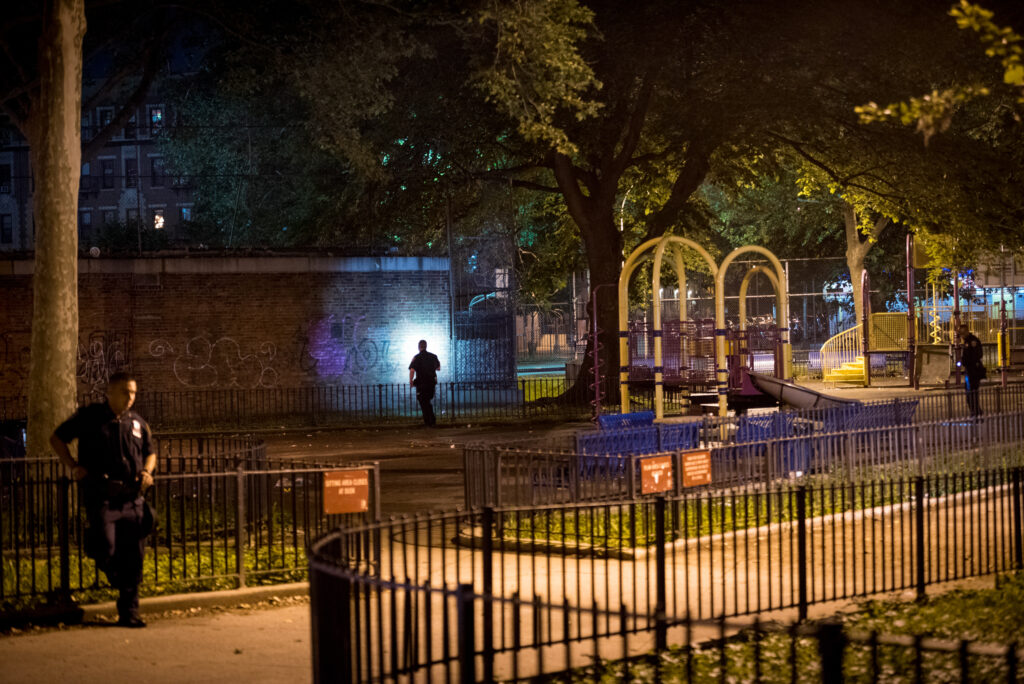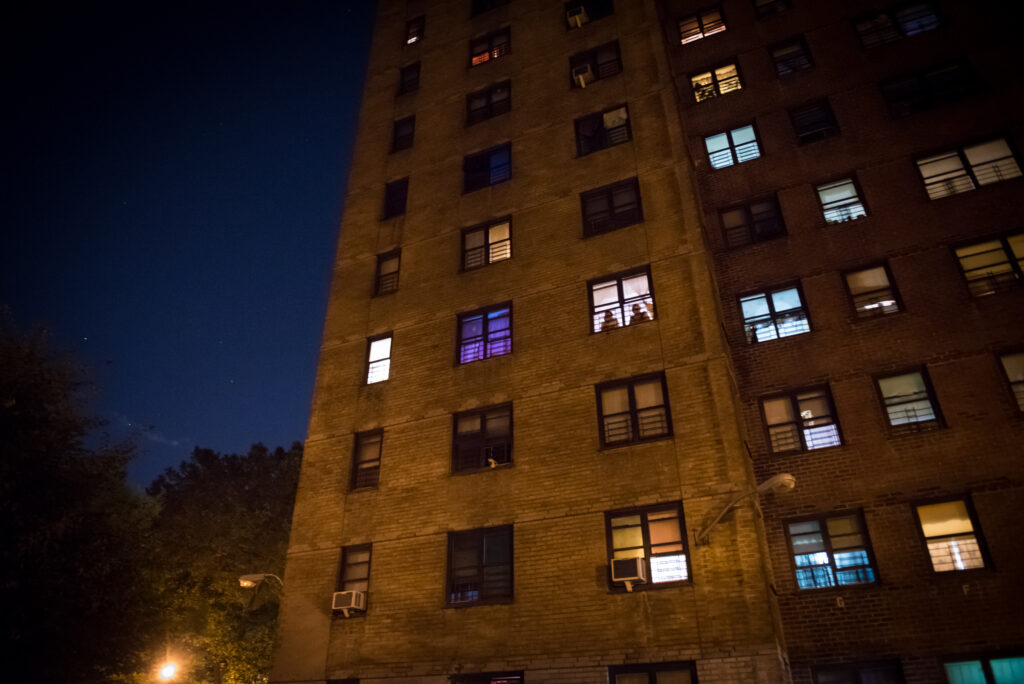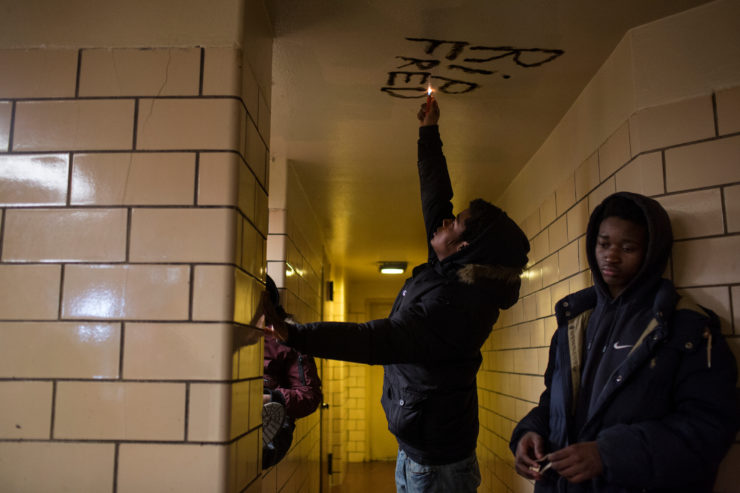When I worked at the Los Angeles Times, one of the things that made me the proudest of the newspaper was its commitment to covering every killing in L.A. County with its Homicide Report. In the face of a daunting toll that could easily devolve into statistics, it has been steadfast in personalizing that toll, providing "a story for every victim."
This year, the New York Times has taken that commitment to a narrative level with its Murder in the 4-0 series, which focuses on the 40th Precinct, "a two-square-mile area at the southern tip of the Bronx where the towers of 14 housing projects dominate the skyline, methadone clinics dot the main thoroughfares, and gangs and drug-dealing wane with each police roundup and then roar back."
Crime has fallen to historic lows in the city, but homicides persist in the 40th Precinct. The Times decided to commit considerable resources to writing a longform story about each homicide victim in the 4-0 this year, with reporters Ben Mueller and Al Baker taking the lead.
"The idea of focusing on every killing in one precinct appealed to me, because I feared with projects like the Homicide Report and even old New York Newsday’s The Toll, you lose track of the humanity as the number grows higher and ever higher. But going deep on a few seemed to be a compelling way of showing the human cost."
The result has been a powerful series that has illuminated entrenched problems in the precinct -- housing projects awash in violence, distrust between residents and police, haphazard social services. But it has done so not with ivory-tower experts and great swaths of statistics, but by making the killings heartbreakingly personal.
"We have tried to make each story unique, and the reality is that if you dig deeply enough, just about every murder is its own powerful story," says New York Times City Editor Henri Cauvin, who's overseeing the project.
Of the 14 homicides so far in the precinct, the Times has published nine stories, the latest of them early this month.
I chatted with Cauvin and Metro Editor Wendell Jamieson about the project. This has been slightly edited for length and flow.

So I think I mentioned that I was involved with some of the narratives that came out of the Los Angeles Times’ Homicide Report. It committed to covering every homicide in the city, to give a face to the faceless. Was that a model for you? Were you aware of it?
Wendell -- Oh yes, of course we were aware of it. We admired it. It’s a model that other organizations have experimented with over the years. I remember when I was a police reporter at New York Newsday in the early 1990s, where there 2,000 killings a year in New York City, and we did a daily feature called The Toll, in which we listed every handgun homicide.
Henri -- I followed the Homicide Report project, as well as DC Homicide Watch, which started when I was at The Washington Post. I think these sort of efforts all spring from a similar desire to make some sort of sense out of murder, but I think we set out do something different from Homicide Report and Homicide Watch.
Talk me through the creation stage: Who had the idea, and what happened between then and publication? I’d love to be granular here. Tell me everything.
Wendell -- I know Henri mentioned it to me one day on the Metro desk, in an offhand sort of way. The more I thought about it, the more I loved it. We’d talked about the Homicide Report before, and had occasionally kicked around similar approaches. But the idea of focusing on every killing in one precinct appealed to me, because I feared with projects like the Homicide Report and even The Toll, you lose track of the humanity as the number grows higher and ever higher.
But going deep on a few seemed to be a compelling way of showing the human cost. And a precinct felt like just the proper geographic decibel-level. We would need to say clearly why we have chosen this precinct, and why it represents the rest of the city, if it does. We considered a few in Brooklyn and the Bronx and chose the 4-0 for several reasons, including that it has many housing projects, and they have become the center of gang-based shootings in New York City.
Henri -- You’re always thinking about about how to elevate your coverage, and Wendell had urged me to think about an immersive way to do that on crime and policing, perhaps by embedding a reporter with a crew (gang) in a housing project. As I was thinking about that, I was reading "Ghettoside" (by Jill Leovy, the Los Angeles Times reporter who founded Homicide Report), and I came to think that we could and should try to write about murder in a really deep way, and that we should focus on a place.
But in picking a place small enough that we could really plunge in, in this case a single precinct, it was impossible to know what we were going to end up with. That, of course, was part of what made it compelling -- you couldn’t pick and choose. And you had to work with whatever came your way, whether it was one murder all year or a dozen murders, or in our case 14 so far.
I thought the project could be great, and so did the reporters. But with so little control over what we would be covering, I kept my initial pitches modest. I didn’t want to raise expectations too high, too soon. And I didn’t want to have to write a lot of memos and convene a lot of meetings -- the sort of things that have ordinarily come with a project of this ambition and depth.
What do you hope to achieve with this project?
Wendell -- To paint an unforgettable picture of murder in our city in the year 2016, and to show that even in a low-crime environment, one human being slaying another still upends and forever changes lives.

How does Black Lives Matter play into this project? Is it the conscious backdrop?
Wendell -- Actually, no.
Henri -- Certainly, we did not sit around and ask ourselves how does The New York Times find a way to jump on the Black Lives Matters movement. But the project is a product of its time, and the last few years in the United States have seen an outpouring of activism -- and journalism -- around race and the country’s criminal justice system.
“The New Jim Crow” by Michelle Alexander I think heralded a period when a lot of people, including a lot of journalists, began to more openly and aggressively question assumptions about the criminal justice system and to examine the impact of the drug war and mass incarceration. I think The Times has done a lot of good reporting on this over the last few years, but in many cases, the stories weren’t new. We just were paying more attention.
The 4-0 stories do not have an explicitly racial element, but the neighborhood we chose is almost entirely black and brown, and the victims are, in most cases, people whose stories would not have been told, particularly those with complicated pasts that do not easily fit into customary crime-story narratives.
How did you choose the writers? And do they both work on this full time? How many resources are you committing to it?
Wendell -- The writers came principally out of our police headquarters bureau. We have three full-time reporters there. We also used a few interns and stringers. Remember, we had to be up there as soon as possible after a killing, no matter the time or day -- and it was often the worse time or day for classic newspaper staffing. As the series got bigger and bigger, and as the number of killings jumped a few months into the year, we called in reinforcements. One of them was Jim McKinley, who covers Manhattan Criminal Court but was a former Mexico City bureau chief. He speaks Spanish beautifully, which was a real asset. Some of the photographers have been deeply committed to the project as well, and have acted as reporters in many instances.
We have tried to make each story unique, and the reality is that if you dig deeply enough, just about every murder is its own powerful story.
Henri -- We envisioned this as a project that would be led by the beat reporters, and that has been the case. Two of them, Al Baker and Ben Mueller, have been on the project almost full time, but this is NY and the NYPD, so when we’ve had really big news -- a wave of corruption arrests, the police commissioner retiring, the bomb blowing up in Chelsea -- we had pull them back into the mix for at least a few days. And the third police reporter, Ashley Southall, who came on the beat a couple of months into the project, has worked on both 4-0 stories and on regular police coverage.
And the photographers, particularly Angel Franco and Edwin Torres, have been instrumental. They both grew up in the Bronx and they have embraced the project and the chance to delve deeply into deaths, and lives, that might otherwise be ignored.
Do they trade off on the writing? Or is one of them more the writer and another more the reporter?
Everyone pitches in on reporting, and one person usually take the lead in writing, in part because the pace of the project doesn’t allow for weeks and weeks of writing and rewriting.
Speaking of the writing, my favorite is the one about the party gone wrong. Such lovely writing throughout. Tell me about the writing and editing process on it.
Henri -- We have tried to make each story unique, and the reality is that if you dig deeply enough, just about every murder is its own powerful story. In the case of the party and Julian Washington’s killing, Wendell thought that it presented an opportunity to recount a murder from up-close and to do it in a tight, fast-moving way that brought the reader into the room and into the chaos. There were lots of witnesses and lots of different accounts, and we embraced that as an element of the story, because that’s often enough the reality. That approach, focusing almost exclusively on the bloodshed, did mean that Julian’s life story and how it figured in him being in that room that night was not explored in depth and certainly not to the degree that we explored other victims’ lives. And that was certainly a tradeoff.
I wanted to talk about the comments. One of the most moving things about the LAT’s Homicide Report was that people who knew the victims often wrote on the comments board, like a memorial page. It gave them a voice. Have you found that type of comment? More broadly, what kind of reaction have you gotten?
Henri -- The NYT moderates comments, so only a small number of stories are opened for comments. By default crime stories, including the 4-0 stories, are not. In the case of the Julian Washington story, they were opened by accident. Some of of the comments that were posted were the sort of ugly rhetoric that we don’t like to attach to a story, especially one that is in some respects an obituary. That said, we did decide to open up a couple of stories for comments -- one was the killing of a woman by her husband and the other was a killing of an innocent bystander. The underlying themes of each of those stories -- domestic violence and policing in poor communities -- were ones that we thought would draw thoughtful comments.
How are you trying to get these stories out to the community? I see you translated two of the stories into Spanish. Are you doing anything else?
We’ve sent a NY push alert for each story and we’ve had a module that allows people to sign up to be notified when the next story publishes. We’ve of course used Twitter and Facebook to share the stories. And yes, we’ve had a couple of the stories translated, both of them in cases where the victims were immigrants from Mexico.
Are you working on a story now?
Yes, and our latest story has just been published.
What’s the most gratifying thing about the project? What’s the hardest thing about it?
Henri -- It has shown what I think many of us who cover crime know in our hearts, that when you dig into a murder, into the life of the victim and the life of the suspect and the people and places around them, there is a powerful story to be told, and that often the cases we would have been most likely not to write about out turn out to be some of the most interesting and most illuminating stories, like this, this and this.
And I think with the Jessica White story, last month, we were able to begin to show readers in a very real way how murder isn’t treated equally, by the city, by the police or by the press. That’s not a revelation on its own, but again it’s one of those things that’s just been accepted about the criminal justice system. The story depicted this in a very stark way that could not be written off and indeed struck a nerve at Police Headquarters.
As for what’s the hardest thing about this, I think that for the reporters in particular, this is taxing work, emotionally, intellectually and even physically. And it is a marathon, for sure. But the reporters working on this aren’t the types to focus on themselves, and they are daily witnesses to a level of pain few of us have to endure and to a degree of resilience that many of us are never asked to muster. That, I think, keeps everything in perspective.



